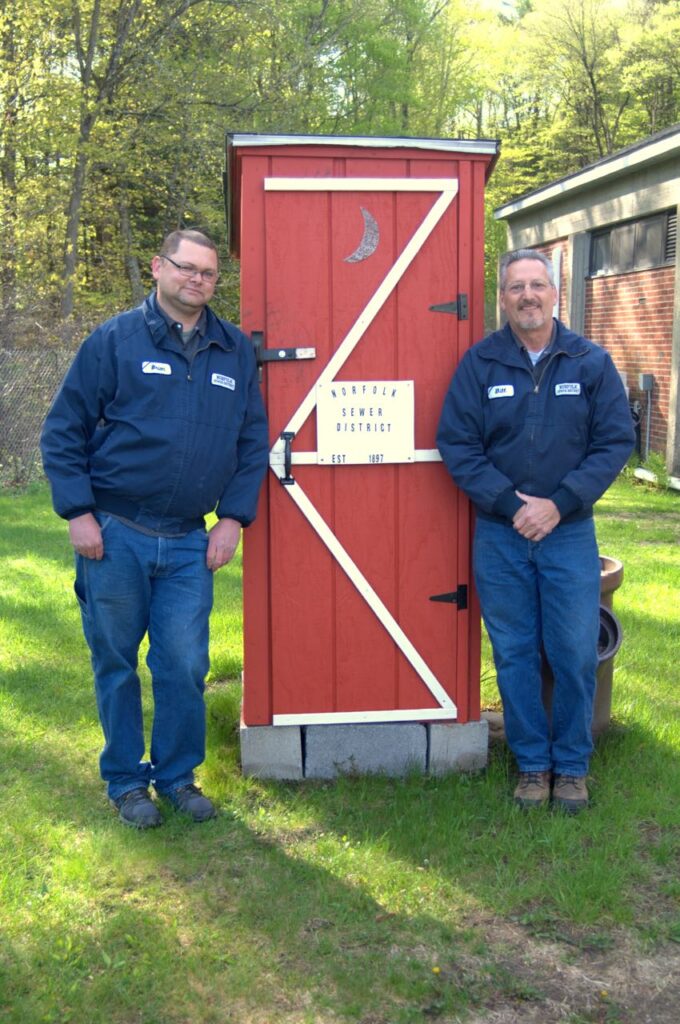Purifying Norfolk’s Wastewater
Process described on Sewer District’s Facebook page
By Doug McDevitt

Too many cups of coffee on a long road trip home, we rush out of the car, fumble with the keys doing a strange wiggle dance and just make it to the lavatory. With our business finished, the commode flushed and hands washed, a great sigh of relief is liberated…glad that’s over. Well, for us it may be, but for Bill Hester and Brian Hutchins of the Norfolk Sewer District it’s just the beginning.
Water is our life blood. Gold, jewels, the hottest stock are always desired but without water we can only live for three days, and people like Hester and Hutchins work hard at keeping our water supply safe or we all would be in serious trouble. The mission at the water treatment plant on Greenwoods Road is simply to protect the public safety, which Hester and Hutchins take very seriously. Walking into the office at the plant is frankly like walking into a laboratory filled with beakers, flasks, analytical equipment and all sorts of charts and certifications, so in our current Covid environment it’s comforting to know that the plant is managed by a team that is very familiar with viral infections; there are many more infectious pathogens and viruses besides SARS-CoV2. The chlorination of the water is very effective at eradicating all viruses including the one that causes Covid-19, and the de-chlorination process ensures that only pure water is being released.
The Norfolk Sewer District was one of the first in Connecticut, established in 1897, and the current plant was built in 1970. In earlier times, wastewater was simply emptied into sand pits where some of the heavier detritus would settle and all of the remaining particulates would spill into the Blackberry River. In 1972, the Clean Water Act was passed to ensure that a better system of water screening be put in place. Now, through a complex web of filtration, including chlorination, clean potable water is released into the Blackberry. In fact, the water from the plant is cleaner than the water already traversing past the outflow pipe. As Bill puts it, “dilution is the solution to pollution.” The upgrading of the Water Resource and Recovery plant is an ever-evolving process. Brian. Hutchins, who is also Norfolk’s assistant fire chief, has brought many new ideas to the plant such as streamlining the control tests that measure how well the filtration tanks are performing, reducing to just one hour a process that initially took two. A new $4.2 million project slated to begin soon will reline the nine and a half miles of older pipes in town with a new fiberglass insert, modernizing the 120-year-old system and making it sustainable for many years to come.
The filtration process is complex, but Brian Hutchins has taken on the task of explaining the functioning of the plant in detail on Norfolk Sewer District’s Facebook page, through a feature called Waste Water Wednesday. Briefly, when the wastewater from the sewer system first enters the water treatment plant there are two large rakes that block some of the bigger items that manage to find their way into the pipes. The water then enters a series of four stirring tanks that house “the bugs”—good bacteria that breakdown the sludge. From there the water is emptied into the older, but still effective, sand pits, where the water will sit. The water is then sent to the chlorination and de-chlorination tanks before finally being released into the Blackberry. In this Covid-19 environment, many people are using more sanitizing wipes than ever before. We can do our part by not flushing sanitizing wipes down the toilet. Hutchins says there is a significant increase in these wipes that with their thin and flexible construct manage to pass through all of the initial rakes and find their way into the filtration equipment, causing significant damage and resulting in more frequent and costly maintenance.
It’s very interesting to see the complete process. From the road the plant is a nondescript building, identifiable by a pretty little garden at the base of the Sewer District sign (nice touch!), but inside is a very scientifically based and professional process that both ensures our safety and contributes to a cleaner environment. We’re fortunate that Bill Hester, a 19-year-veteran, and Brian Hutchins are here in Norfolk to continually change a muddy puddle into a sparkling, babbling brook.
